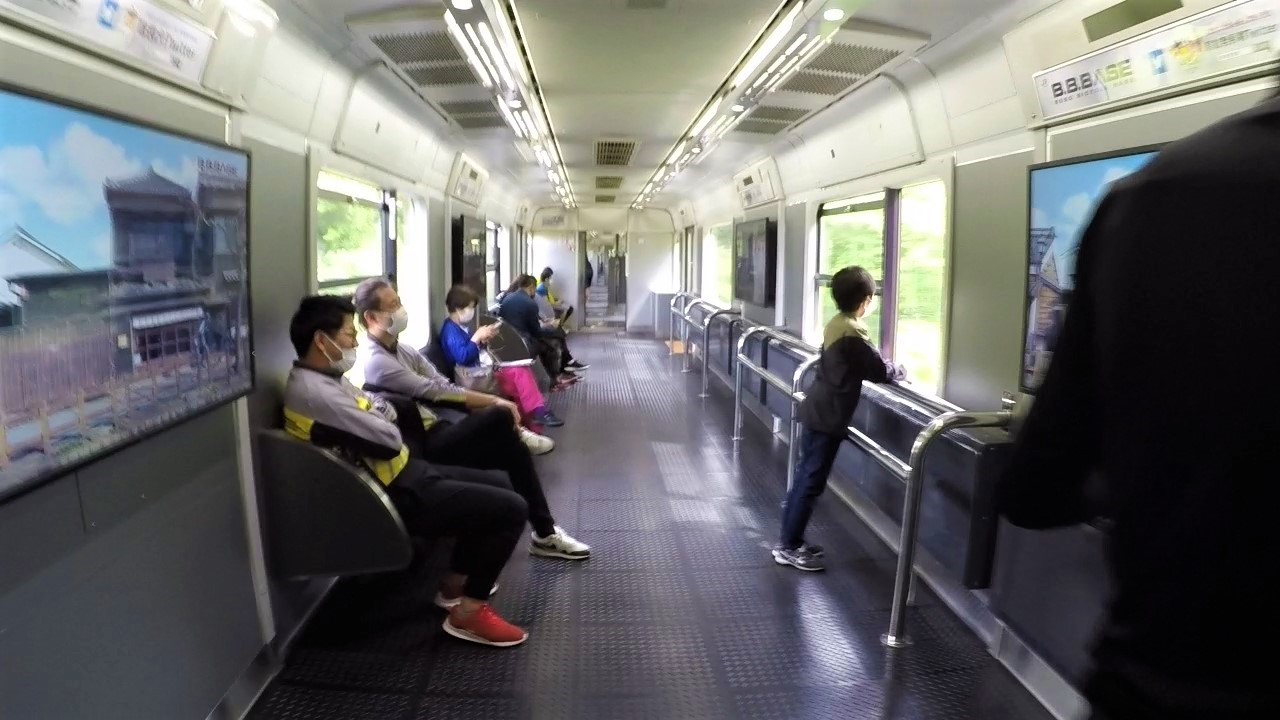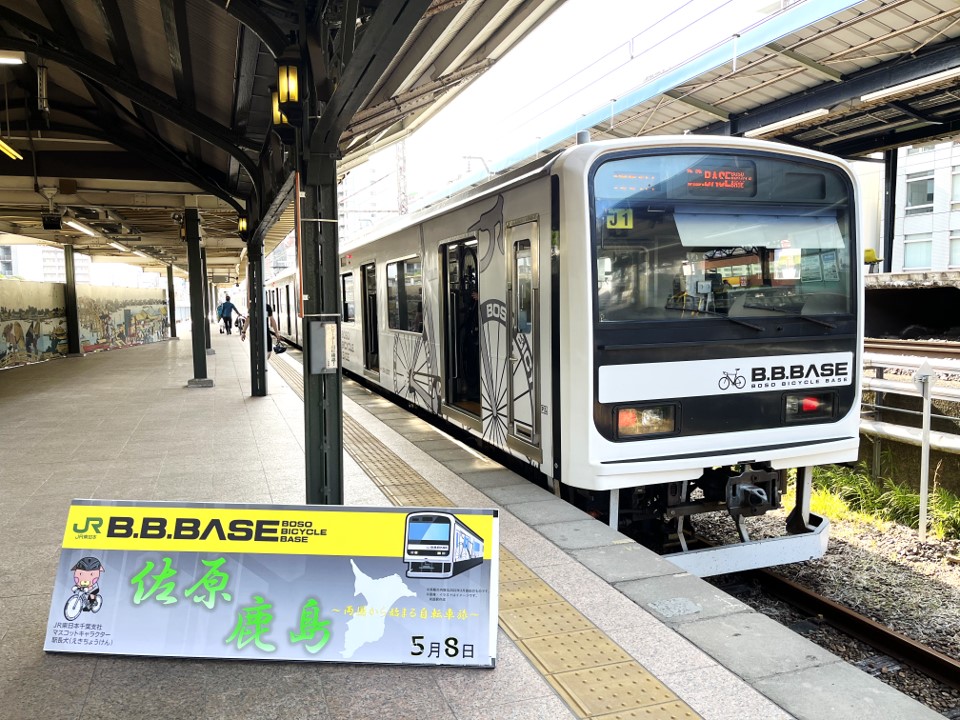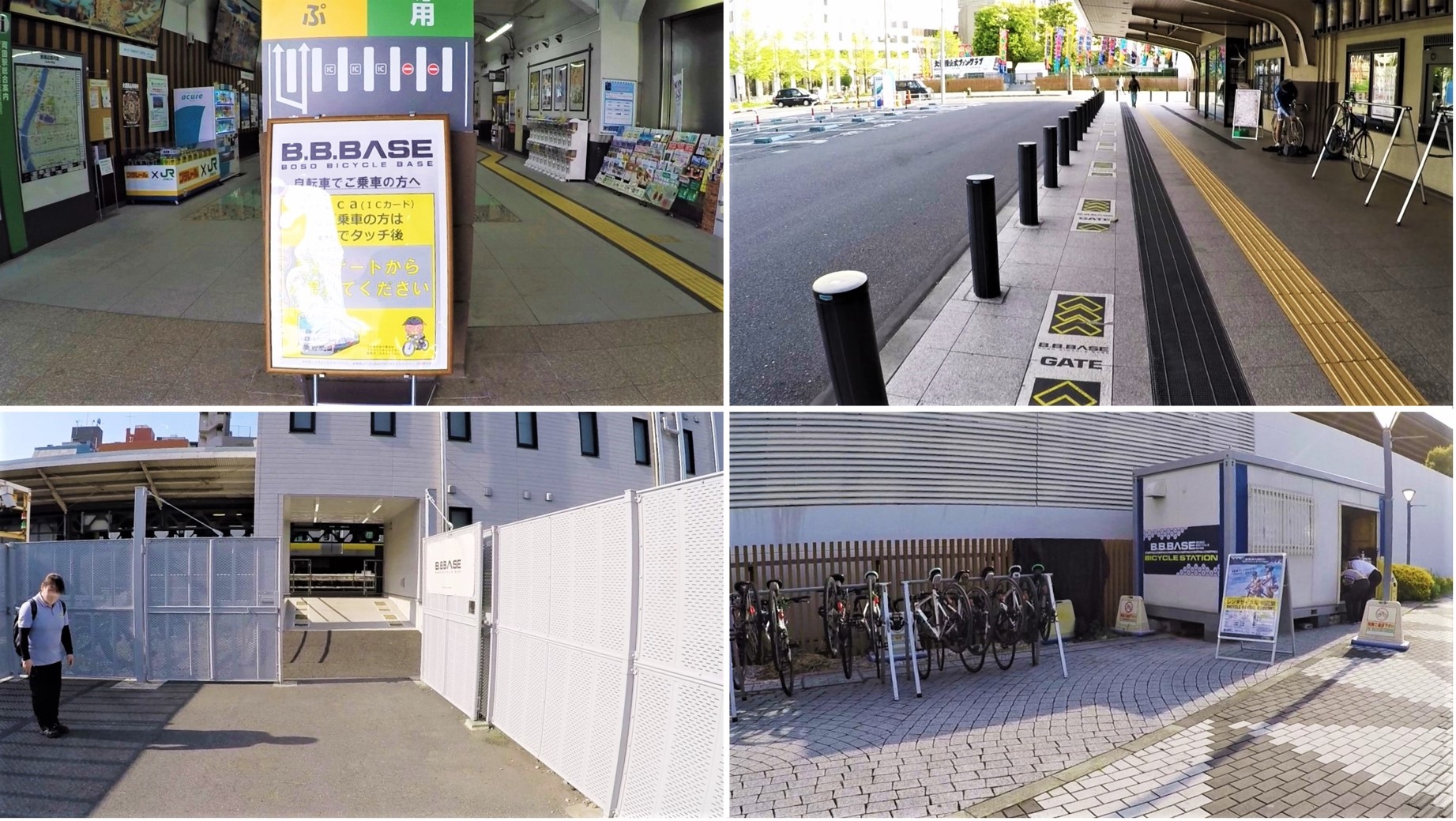Riding the B.B.BASE and discovering Kashima on a bicycle!

Ladies and gentlemen, say hello to the B.B.BASE, a Joyful Train by JR East that is specially for cycling enthusiasts or those who would like to give cycling a try on top of their railway trip. The train made its debut in January 2018, and operates on refurbished 209 series trains.
Its name stands for “BOSO BICYCLE BASE”, and its concept is to allow passengers to discover the Boso Peninsula (房総半島 Bōsō hantō) and neighbouring regions by rail and cycling, where they can ride the train and enjoy the splendid views of the peninsula, and continue on a cycling trip after that for more intimate exploration.

The B.B.BASE. (Image credit: JR East Chiba Branch)
Cycling is one of the best ways to discover a new place, and the B.B.BASE provides passengers with an opportunity to travel by rail together with a bicycle. Not only does the train help passengers to reach their destination, but it also offers wonderful views of the region, building up the excitement of their cycling adventure.

Map of the B.B.BASE’s train routes. (Image credit: Google Maps)
The train departs from JR Ryōgoku Station (JR両国駅) for all courses, and there are five different routes that passengers can choose from:
① Uchibō Course (内房): JR Ryōgoku Station → JR Wadaura Station (JR和田浦駅), JR Tateyama Station (JR館山駅) → JR Ryōgoku Station
② Sotobō Course (外房): JR Ryōgoku Station ↔ JR Awa-Kamogawa Station (JR安房鴨川駅)
③ Sawara / Kashima Course (佐原・鹿島): JR Ryōgoku Station ↔ JR Kashimajingū Station (JR鹿島神宮駅)
④ Sakura / Chōshi Course (佐倉・銚子): JR Ryōgoku Station ↔ JR Chōshi Station (JR銚子駅)
⑤ Mount Kano / Saikuru Train Course (鹿野山・菜久留トレイン): JR Ryōgoku Station → JR Kimitsu Station (JR君津駅) with a transfer at JR Kisarazu Station (JR木更津駅), JR Takeoka Station (JR竹岡駅) → JR Ryōgoku Station
Unlike other Joyful Trains, the train is specially fitted with bicycle racks so that passengers can bring their bicycles with them on board the train and mount them onto the racks safely, allowing them to enjoy the train ride with ease. How novel and convenient is that!

Layout of the B.B.BASE. (Image credit: JR East)
The train is made up of six cars and has 99 seats altogether. The train exterior is adorned with the train name and the car number in bold letters, with Car 1 as the first train when in the direction towards JR Ryōgoku Station. Let's check out what it looks like inside.
Cars 1–3, 5–6: Passenger cars with bicycle racks

Inside Car 5. (Image credit: JR East / Kobori)
Cars 1, 2, 3, 5, and 6 are the passenger cars with 19–20 seats each in a 2+1 configuration. With this layout, passengers will have ample space to guide their bicycles inside the train cars. The seats are also equipped with power outlets, and the train cars feature anti-slip rubber flooring so that passengers can move around the train safely, especially if they’re wearing bicycle footwear. Passengers may also bring their own food and beverages onboard, as there are no food and beverage sales on the train.

Bicycle racks inside the train cars. (Image credit: JR East / Kobori)
Simple and easy-to-use bicycle racks are also fixed near the doors of the train cars, so passengers can mount and dismount their bicycles quickly when getting on and off the train. Not sure how to use the racks? Not to worry; just follow the steps below:
① Grab the hook and pull the frame guide out towards you (tip: if your bicycle is small, only one joint of the frame guide will be enough)
② Place your bicycle’s front wheel on the frame guide (tip: mount the front wheel on the frame guide first and then push in the rear wheel)
③ Secure the bicycle with the strap that is attached to the frame guide
④ You’re all set!
Car 4: Open space

Inside Car 4. (Image credit: JR East / Kobori)
Car 4 is a car featuring an open space with seats. Passengers can use the space and seats freely, but the space may be used for special events on certain occasions. Currently, the car is equipped with screen panels that showcase the charms of the Boso Peninsula and offer the passengers some inspiration for their cycling adventures.
Exploring the Sawara / Kashima Course

The Sawara / Kashima Course. (Image credit: Google Maps)
Just recently, our JR East colleagues had the chance to explore the Sawara / Kashima Course and had a fun-filled day of riding the train and cycling in the countryside. Let’s find out more about their travelling experience, and how you can do the same too!
① Embarking from JR Ryōgoku Station

JR Ryōgoku Station. (Image credit: JR East / Kobori)
Our friends kicked off their journey from JR Ryōgoku Station, where the B.B.BASE departs from. The station is located on the eastern side of the Tokyo Metropolitan Area, which makes it very convenient for those based in Tokyo to access, especially if they're riding the train with their bicycles. Once they arrived at the station, they hopped on board with their bicycles, which they found to be a breeze.

Outdoor view from inside the train. (Image credit: JR East / Kobori)
During their train ride, they were pleasantly surprised by the scenic view they got to enjoy en route to their destination. Their journey was filled with views of the sea and the countryside, and they became more excited by the minute of their cycling trip.
② Starting the cycling route from JR Kashimajingū Station

JR Kashimajingū Station. (Image credit: JR East / Kobori)
After a relaxing ride on the train, our friends finally arrived at JR Kashimajingū Station, the last stop on the Sawara / Kashima Course. This was where they dismounted their bicycles and began their cycling adventure around the city of Kashima (鹿島市 Kashima-shi), which they found to be very pleasant to explore by bicycle!
③ Discover Kashima Shrine

Kashima Shrine’s main torii gate. (Image credit: JR East / Kobori)
When it comes to Kashima, perhaps the most famous landmark is Kashima Shrine (鹿島神宮 Kashima-jingū), an iconic Shintō shrine that is one of the must-visit spots while exploring the Sawara / Kashima Course. It is just a short walk (or cycle) from JR Kashimajingū Station, and it was the first spot that our friends discovered during their cycling trip.
Upon arriving at the shrine, visitors will lay their eyes on another imposing torii gate at the entrance. It is the shrine’s main torii gate (大鳥居 ōtorī), and it is a reconstruction of the original gate. The gate was originally made from granite and built in 2004, but it was destroyed during the Great Eastern Japan Earthquake and Tsunami (東日本大震災 Higashi-nihon daishinsai) in 2011. The gate was reconstructed using weather-resistant steel, and it was completed only recently in June 2014.

Kashima Shrine’s tower gate. (Image credit: JR East / Kobori)
After passing through the main torii gate, you will come across a majestic crimson tower gate (楼門 rōmon) that is one of the impressive structures in the shrine. Built in 1634, the 13m gate is an Important Cultural Property (重要文化財 jūyō-bunkazai) and has been meticulously preserved to this day, with the last renovation taking place in 1965. It is also one of Japan’s Three Main Tower Gates (日本三大楼門 Nihon Sandai Rōmon), alongside the ones in Hakozaki Shrine in Fukuoka, and Aso Shrine in Kumamoto.

Inside the shrine. (Image credit: JR East / Kobori)
Do you know that Kashima Shrine’s complex has a total area of 23.5 hectares? Other than the imposing main torii gate and tower gate mentioned above, many other discoveries await you in the shrine complex. They include Futsu-no-Mitama (布都御魂剣), a large blade kept in the Treasure House (宝物殿 hōmotsuden) that has been designated as a National Treasure (国宝 kokuhō); the main shrine building (本殿 honden), and the prayer hall (拝殿 haiden), both of which are also designated as Important Cultural Properties.
Plus, there’s also a deer park in the complex, similar to the famous one at Nara Park. Fun fact: deers are considered messengers of the gods, and thus are revered as sacred animals.
Kashima Shrine (鹿島神宮)
Address: 2306-1 Kyuchu, Kashima, Ibaraki 314-0031
Access: 10-minute walk from JR Kashimajingū Station (JR鹿島神宮駅)
Opening hours:
24 hours (shrine complex)
8am–4pm (treasure house)
Admission fee:
None (shrine complex)
¥300 per adult (treasure house)
④ Spot the first torii gate of Kashima Shrine

Nishi-no-Ichi-no-Torii. (Image credit: JR East / Kobori)
The area around JR Kashimajingū Station is known for its serene atmosphere, and most of all, a cycling-friendly environment. Visitors can hop on a bicycle and leisurely explore the area around it, and one of the most scenic spots in the area is the route along the Wani River (鰐川 Wani-gawa), which stems from the nearby Lake Kitaura (北浦湖 Kitaura-ko).
As our friends cycled along this pleasant route and soak in the laid-back ambience, they found a conspicuous torii gate standing up from the river. It is the Nishi-no-Ichi-no-Torii (西の一之鳥居 First Gate of the West), which is the first torii gate for Kashima Shrine. It was built in 2013, and with a height of 18.5m and width of 22.5m, it is one of the largest torii gates in Japan. Don’t miss this landmark when you cycle around the area on your next cycling adventure!
⑤ Gaze at the Kitaura Bridge

The B.B.BASE crossing the Kitaura Bridge. (Image credit: JR East Chiba Branch)
After spotting the torii gate, they cycled along the path just up north and found another splendid scenery: the Kitaura Bridge (北浦橋梁 Kitaura-kyōryō). It is located next to the torii gate, stretching over Lake Kitaura and serves the Kashima Line (鹿島線) that connects to JR Kashimajingū Station.
Isn’t it relaxing to simply take it easy and gaze at pretty scenery? Cycling is a great way to spot scenery that you would have otherwise missed if you travel by other means, and this is one of the lesser-known spots where you can take a break before you’re off to your next discovery.
⑥ Flowers galore at Suigo Sawara Ayame Park

Suigo Sawara Ayame Park. (Image credit: JR East / Kobori)
Are you a big flower fan? Our friends most certainly are, and as they cycled across the Jingu Bridge (神宮橋) and then the Itako Ōhashi Bridge (潮来大橋) over the Hitachitone River, they came across a sprawling flower park that is home to a plethora of irises (あやめ ayame) blooming gloriously in early summer.

Irises blooming at the park. (Image credit: 千葉県観光物産協会)
Welcome to Suigo Sawara Ayame Park (水郷佐原あやめパーク Suigō Sawara Ayame Pāku), a beautiful park that opened recently in April 2017. The park used to be known as Suigo Sawara Aquatic Botanical Garden (水郷佐原水生植物園 Suigō Sawara Suisei-shokubutsu-en), and has always been much loved by the locals for its irises sprawling across eight hectares of land.
At the park, up to 1.5 million irises of 400 different varieties such as Edo (江戸), Higo (肥後), and Ise (伊勢) bloom usually in June, fascinating all visitors with their vibrant colours. The park is also known for lotuses (はす hasu), which bloom later in the summer.

Taking a boat ride at the park. (Image credit: 千葉県観光物産協会)
While exploring the park, why not enjoy your time by riding on a boat too? Visitors can hop on a boat and soak in the magnificent scenery around them as it gently moves along the water. It’s one of the most popular activities in the park, and something that I would highly recommend to all visitors.
The best time to view irises at the park is from late May to mid-June, and if you’re in town during this period, then you don’t want to miss the Ayame Festival (あやめ祭り), when the irises are in full bloom. Later on, from early July to mid-August, the Hasu Festival (はす祭り) is held, when visitors will get to see lotuses in full view on the placid waters in the park.
(Note: the Ayame Festival and Hasu Festival are held from 28 May to 19 June and from 2 July to 14 August respectively. The dates may be subject to change every year).
Suigo Sawara Ayame Park (水郷佐原あやめパーク)
Address: 1837-2 Ogishima, Katori, Chiba 287-0801
Access: From JR Sawara Station (JR佐原駅), take the Sawara Loop Bus and alight at the Suigo Sawara Ayame Park bus stop. The bus ride takes around 20 minutes per one way. (Note: during the Ayame Festival, there is a shuttle bus running daily from JR Sawara Station to the park, with a fare of ¥500 per one way per adult)
Opening hours:
9am–4:30pm (ordinary days)
8am–6pm (Ayame Festival)
8am–4:30pm (Hasu Festival)
Admission fee:
¥200 per adult (April, September–November)
¥600 per adult (May–August)
¥800 per adult (Ayame Festival)
None (December–March)
⑦ Travel back in time in Sawara’s “Little Edo”

Sawara Koedo. (Image credit: JR East / Kobori)
Next, they continued cycling southwards, and found a town that made them feel like they have travelled back in time. That is because, in the city of Sawara (佐原市), there lies a historical town that would make visitors feel like they’re experiencing the old capital city of Japan.

Sawara Koedo’s historical buildings and canal. (Image credit: JR East / Kobori)
Sawara is home to its own “Little Edo” (小江戸 ko-edo), a historical canal town featuring buildings and architecture from the Edo Period (1603–1867). Sawara used to be prosperous as a merchant town during this period, with merchants often coming here thanks to its direct access to the Tone River (利根川 Tone-gawa).

Toyohashi Bridge in the historical town. (Image credit: JR East / Kobori)
Many of the merchant houses and warehouses from that period have been carefully preserved to this day, and visitors can have a nostalgic glimpse of what the street used to be like in the past. They can even see the canal running through the street, the same one that was used by merchants back then for transportation, and ride a leisure boat to have a view of the town right from the canal.
Also, you might be interested to know that Kashima's Sawara area is known as a "water town" (水郷 suigō), which is a scenic town with lakes and rivers running through them. If you like to find other charming water towns such as Sawara, there are others nearby such as Katori (香取市 Katori-shi) in Chiba and Itako (潮来市 Itako-shi) in Ibaraki.
Sawara Little Edo (佐原小江戸)
Address: I-1730-3 Sawara, Katori, Chiba 287-0003
Access: 10–15-minute walk from JR Sawara Station (JR佐原駅)
⑧ Wrap up their cycling adventure at JR Sawara Station

JR Sawara Station. (Image credit: JR East / Kobori)
Once they had explored the historical canal town of Sawara’s Little Edo, they slowly made their way to JR Sawara Station, which is only a short walk/cycle away. This station is one of the main stops for the B.B.BASE, and marks the perfect spot to end your cycling adventure on the Kashima / Sawara Course.

Parking their bicycles outside JR Sawara Station. (Image credit: JR East / Kobori)
Before hopping on the train at the station, they took their time to admire the station building first. The railway station’s current building was completed in 2011, and unlike its more modern counterparts, its design hearkens back to architecture from the Edo Period. A perfect way to mark the end of their adventure around Sawara with a tinge of nostalgia, don’t you think?

Marking the end of their cycling trip. (Image credit: JR East / Kobori)
With that, they had come to the end of their cycling journey. It was a memorable experience for our friends, and after exploring Kashima and Sawara, they felt like exploring the other courses as well. They sincerely want everyone else to consider taking the B.B.BASE and discover the joys of riding a bicycle through the idyllic countryside and explore new areas more intimately.

Boarding the B.B.BASE at JR Sawara Station. (Image credit: JR East / Kobori)
Closing
Travelling by rail is a great way to explore different parts of Japan, and doing so in the Boso Peninsula is no exception. The peninsula’s wonderful views, rich history, and splendid ambience make it a wonderful destination, especially for those based in Tokyo thanks to its direct railway access, making for convenient transportation.
However, why not try cycling on your next railway adventure? The B.B.BASE allows passengers to experience the wonders of exploring the peninsula by rail and bicycle, giving them a more up-close look into its charms. It’s a unique experience that I think everyone should give a try!
How to ride the B.B.BASE

Boarding the B.B.BASE. (Image credit: JR East / Kobori)
The B.B.BASE runs mostly on weekends and some selected weekdays, including those during the Golden Week. The train route is based on the course, and each course departs only on selected dates, so passengers are highly encouraged to check the schedule and timetable here to make the necessary arrangements. The train departs once per day, and all seats on the train require seat reservations, which can be made online up to 1 month before your departure here.
For the different courses, JR East has created several bike courses of various lengths that travellers can use for their cycling routes which you refer to here. Do note that the courses are in Japanese only, but they are linked to Strava map routes that can be viewed by anyone.

Directions to the B.B.BASE gate. (Image credit: JR East)
The B.B.BASE can be accessed from JR Ryōgoku Station, which is a 15-minute train ride away from JR Tōkyō Station. After arriving at the railway station, you can make your way from the West Exit (西口) around the Ryōgoku Edo NOREN (-両国- 江戸NOREN) building to the B.B.BASE Gate at the northern side of the station (tip: if you’re not sure of the way, simply follow the yellow guided path marked clearly on the floor). Do note that this entrance is for B.B.BASE passengers who are boarding the train with bicycles.

Directions for B.B.BASE passengers (clockwise from top left): JR Ryōgoku Station’s West Exit, yellow guided path to the B.B.BASE gate, B.B.BASE BICYCLE STATION, entrance for passengers with bicycles. (Image credits: JR East / Kobori)
If you want to go cycling but don't own a bicycle, there are bicycles available for rent at the B.B.BASE BICYCLE STATION at the gate. There are also different types to choose from, such as road bikes and cross bicycles. And if you are new to cycling, you can approach any of the friendly staff who would be more than happy to teach you the basics and safety tips. After you have collected your bicycle, you can make your way up the path leading to Platform 3 where the B.B.BASE departs from.

Renting a bicycle at the B.B.BASE Bicycle Station. (Image credit: JR East / Kobori)
If you’re planning to bring your own bicycle on board the train, take note that there are some guidelines that all passengers must adhere to, such as the tire size and wheelbase length. Some types of bicycles, such as those with kickstands in the back tire, or those equipped with mudguards, may not be allowed on the trains so it’s highly encouraged for passengers to check first and make the necessary arrangements beforehand.

Bicycle size guidelines on the train. (Image credit: JR East)
For those who are riding the B.B.BASE without a bicycle, they can board the train via the ticket gates. First-timers to the station will be surprised to find a gallery featuring portraits and handprints of famous sumo wrestlers. The district around the station has been historically known as a mecca for sumo wrestling, and just next to the station is Ryōgoku Kokugikan (両国国技館), an iconic venue that has hosted many sumo wrestling tournaments and houses a sumo museum.

Handprints of famous sumo wrestlers (left) and Ryōgoku Station Gallery (right) inside the station. (Image credit: JR East / Kobori)
There is also the Ryogoku Station Gallery, a luxurious hallway that displays the rich history of railways in Japan and the station itself, with nostalgic photos of trains of the past. A red carpet is even laid out here, so passengers will feel like esteemed guests as they make their way up the platform for their train ride.
JR TOKYO Wide Pass

The JR TOKYO Wide Pass and where you can use it. (Image credit: JR East)
If you want to ride the B.B.BASE and explore the Boso Peninsula, consider the JR TOKYO Wide Pass, an affordable pass that offers unlimited rail travel on JR East lines (including bullet trains) in the valid area for 3 consecutive days. At only ¥15,000, it makes for a great option for railway travellers covering many areas during their trip.
You can also make seat reservations for bullet trains, some limited express trains and Joyful Trains online for free, up to 1 month in advance, on the JR-EAST Train Reservation.

The JR-EAST Train Reservation. (Image credit: JR East)
Header image credit: JR East / Kobori






